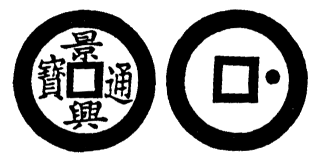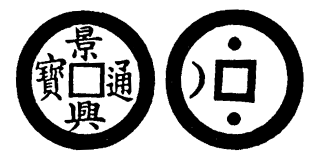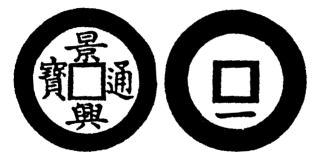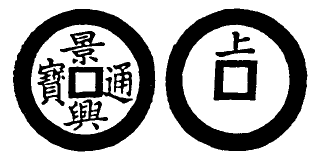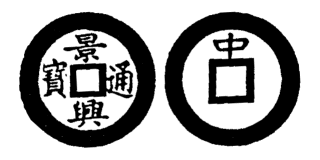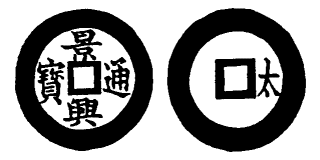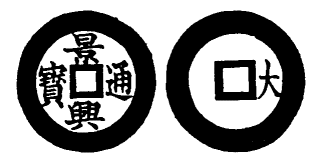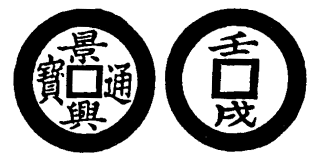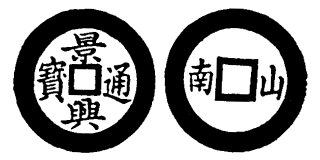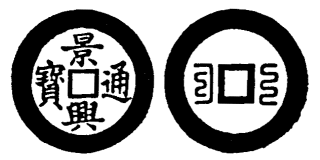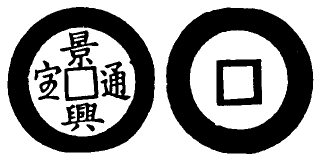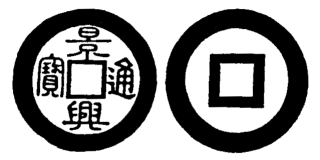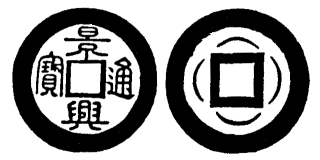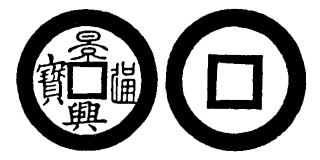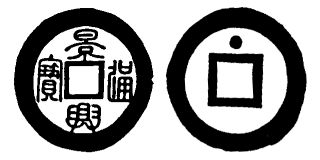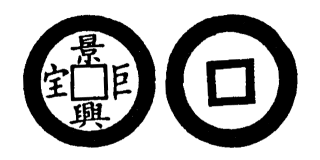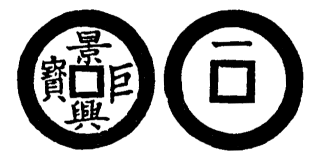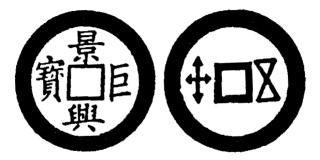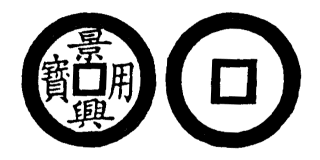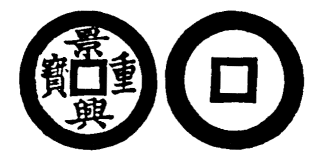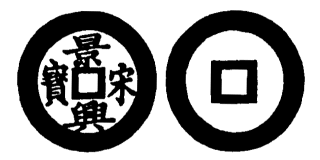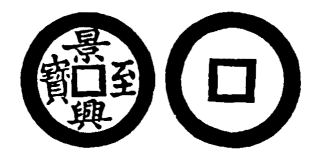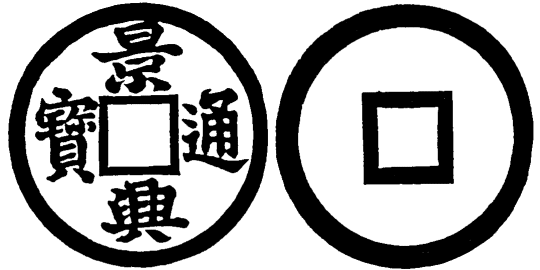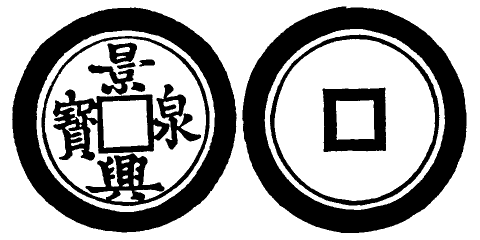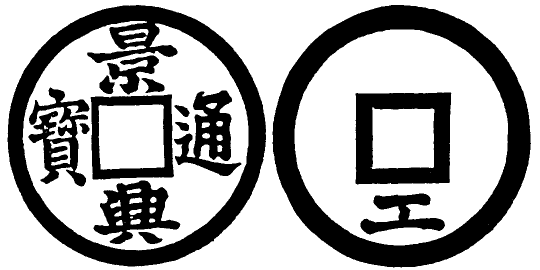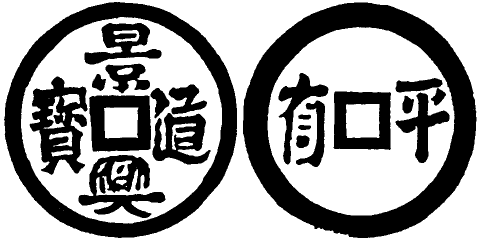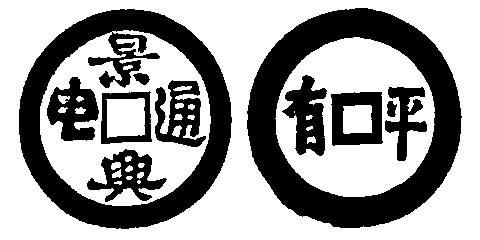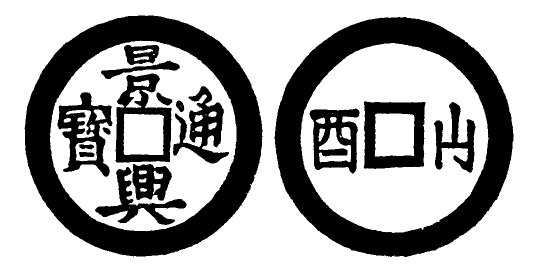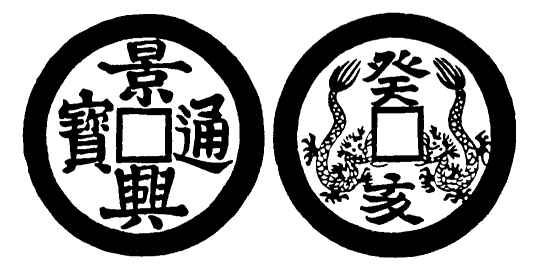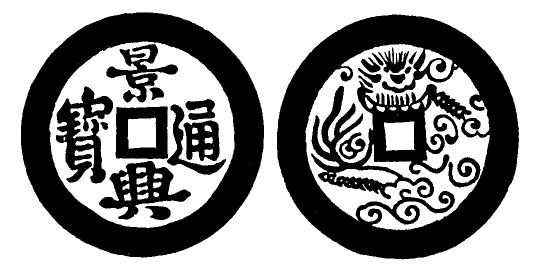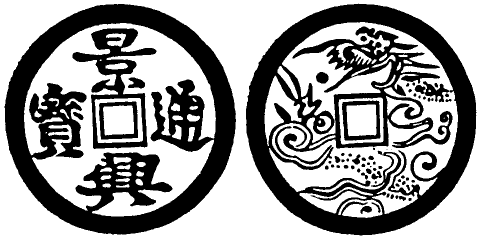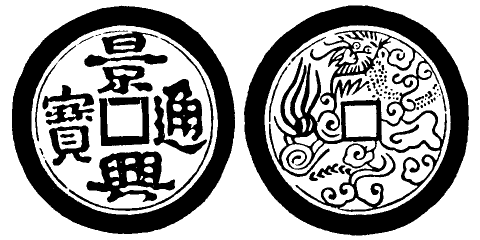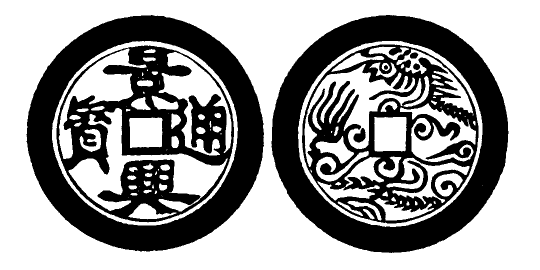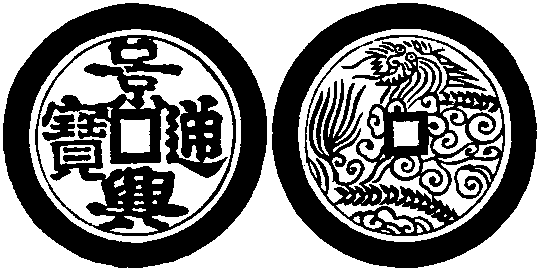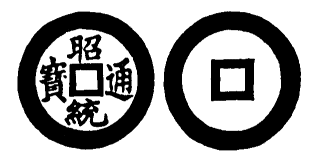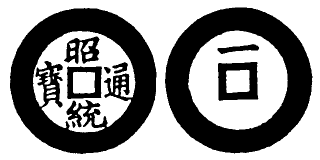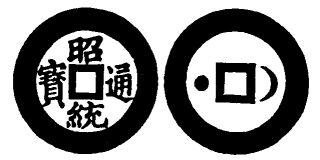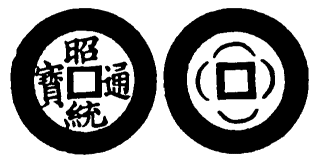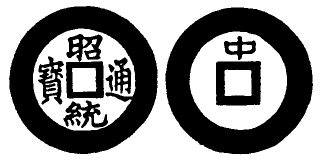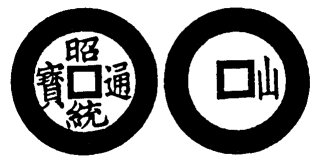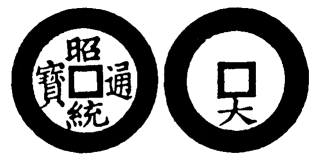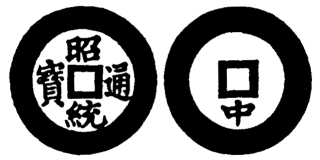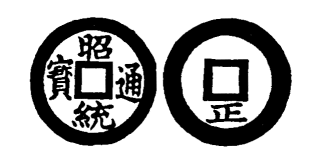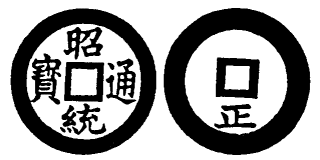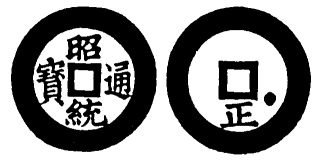Coins and Banknotes of Vietnam
and French Indochina
XVI. The 黎 Le Dynasty. - 1428-1785. (continued)
25th King. - 顯宗 HIEN-TONG. 1740-1786. The rebellions which broke out in Tunquin during this period, were almost without number. Princes belonging to the Royal family, generals, civil mandarins, common people, and out-casts from the hills, all rose in the provinces against the tyranny of the Trinh, as well as for their personal interests. Hien-tong was no more king than his predecessors, and Trinh-dinh bore up bravely against the weight of so many wars, which were at last subdued through the good organization of his army, and owing to the rapidity with which he moved from one province to the other. He died in 1765 and was succeeded by his son 鄭參 TRINH-SUM, who, having restored peace in Tunquin, availed himself of the troubles in Cochinchina caused by the 西山 Tay-son rebellion, to invade that country with an army of thirty thousand men, who soon occupied Hue, the capital of the Nguyen. Trinh-sum received there the submission of the rebel chief and handed over to him the government of the Quang-nam province. Hearing that rebels had made their appearance in Tunquin, Trinh-sum hurried back to Ha-noi, having king Hien-tong still with him. He died in 1781 and was succeeded by his son 鄭佳 TRINH-GIAI, who, seeing his power seriously endangered by a rebellion among his own troops, committed suicide in 1785, to avoid falling alive into the hands of the Tay-son chief 文惠 VAN-HUE. King Hien-toing was ill in his palace, when the rebel entered it and submitted at once to the royal authority. The king died in the 9th moon of 1785.
In 1740 King HIEN-TONG ascended the throne, and during his reign a larger quantity of cash were cast than during that of any former king. Some of the coins issued under his directions have on the reverse the characters denoting the province or mint in which they were cast; and others, instead of the characters 通寶 thong-bao, current coin, or 元寶 nguyen-bao, original coin on the obverse, have other characters substituted as will be seen hereafter.
It was also at that time that the casting of larger cash began, these being meant to be given away as a royal reward to deserving officers; but owing to their number and the value of the copper used they soon found their way into circulation.
No. 76. (Barker: 68.1-68.34)
Obverse: 景興通寶 Canh-hung-thong-bao.
Reverse: plain, with a broad rim. Red and white copper.
No. 77. (Barker: 68.1-68.34)
Obverse: Same as before. Coin of smaller size and made of tin mixed with a little copper.
No. 78. (Barker: none)
Obverse: Same as No. 76.
Reverse: A round dot over the hole.
No. 79. (Barker: none)
Obverse: Same as No. 76.
Reverse: A dot on the right of the hole.
No. 80. (Barker: none)
Obverse: Same as No. 76.
Reverse: A dot at the top, another at the bottom, and a moon on the left side of the hole.
No. 81. (Barker: 68.62)
Obverse: Same as No. 76.
Reverse: The character 一 Nhat, one, meaning one cash, the value of the coin.
No. 82. (Barker: none)
Obverse: Same as No. 76.
Reverse: The character 大 Dai, great, for the province of 清華 Thanh-hoa, the great province, in which the coin was issued.
No. 83. (Barker: none)
Obverse: Same as No. 76.
Reverse: The character 小 Siu, small or minor, meaning the other provinces of Tunquin.
No. 84. (Barker: 68.59-68.61)
Obverse: Same as No. 76.
Reverse: The character 京 kinh, capital, for Hue.
No. 85. (Barker: 68.63)
Obverse: Same as No. 76.
Reverse: The character 北 Bac, north, for the northern provinces.
No. 86. (Barker: none)
Obverse: Same as No. 76.
Reverse: The character 上 Thuong, superior, for the provinces near Yunnan.
No. 87. (Barker: 68.66)
Obverse: Same as No. 76.
Reverse: The character 中 Trung, middle, for the province of Thanh-hoa.
All the above-mentioned coins have the character of the reverse above the bole.
No. 88. (Barker: 68.77-68.78)
Obverse: Same as No. 76.
Reverse: The character 太 Thai, for the province of 太原 Thai-nguyen.
No. 89. (Barker: none)
Obverse: Same as No. 76.
Reverse: Same as No. 82.
The two last-named have the character of the revcrse on the right side of the hole.
No. 90. (Barker: 68.75-68.76)
Obverse: Same as No. 76.
Reverse: The character 工 Cung, for the Board of Public Works by which the coin was issued.
No. 91. (Barker: 68.64)
Obverse: Same as No. 76.
Reverse: Reverse. The character 西 Tay, west, for the western provinces.
No. 92. (Barker: 68.67-68.68)
Obverse: Same as No. 76.
Reverse: Same as No. 87.
The last three coins have the character of the reverse under the hole.
No. 93. (Barker: 68.54-68.55)
Obverse: Same as No. 76.
Reverse: The cyclical characters 庚申 Canh-than, corresponding to the year 1740.
No. 94. (Barker: 68.56)
Obverse: Same as No. 76.
Reverse: The cycle characters 辛酉 Tan-dau, corresponding to the year 1741.
No. 95. (Barker: 68.57)
Obverse: Same as No. 76.
Reverse: The cycle characters 壬戌 Nham-thuat, corresponding to the year 1742.
No. 96. (Barker: 68.69-68.73)
Obverse: Same as No. 76.
Reverse: The characters 山西 Son-tay, name of a province of modern Tunquin.
No. 97. (Barker: 68.58)
Obverse: Same as No. 76.
Reverse: The characters 山南 Son-nam, former narne of a province of Tunquin.
No. 98. (Barker: none)
Obverse: Same as No. 76.
Reverse: The characters 八文 Bat-van, written in the 科斗 Khoa-dan style, meaning that the value of the coin is equal to eiglit small cash.
No. 99. (Barker: 68.82)
Obverse: Same as No. 76.
Reverse: The characters 六分 Luc-phan, written in the 體篆 The-triem or seal style, in allusion to the weight of the cash.
No. 100. (Barker: 68.37-68.39)
Obverse: Same as No. 76, but with the character 寶 Bao written in a contracted form.
Reverse: plain.
No. 101. (Barker: see 68.40)
Obverse: Same as No. 76, but with the character 寶 Bao written in the running hand style.
Reverse: plain.
No. 102. (Barker: see 68.41-68.51)
Obverse: Same as No. 76, but with the characters 景寶 Canh-bao written in the seal style.
Reverse: plain.
No. 103. (Barker: none)
Obverse: Same as No. 102.
Reverse: with two dots on the right side and under the hole.
No. 104. (Barker: none)
Obverse: Same as No. 102.
Reverse: Four curved lines on the four sides of the hole.
No. 105. (Barker: see 68.41-68.51)
Obverse: Same as No. 76, but with the characters 景通 Canh-thong written in the seal style.
Reverse: plain.
No. 106. (Barker: none)
Obverse: Same as No. 105.
Reverse: Four straight lines on the four aides of the hole.
No. 107. (Barker: 68.43-68.44)
Obverse: Same as No. 76, but with the four characters written in the seal style.
Reverse: plain.
No. 108. (Barker: none)
Obverse: Same as No. 107.
Reverse: A dot above the hole.
No. 109. (Barker: none)
Obverse: Same as No. 107.
Reverse: A dot on the left hand corner above the bole.
No. 110. (Barker: none)
Obverse: Same as No. 107.
Reverse: Two dots above the hole.
No. 111. (Barker: 69.1-69.4)
Obverse: 景興巨寶 Canh-hung-cu-bao, or Precious currency of CANH-HUNG.
Reverse: plain.
No. 112. (Barker: 69.5)
Obverse: Same as before, but with the character 寶 Bao written in a contracted form.
No. 113. (Barker: 69.6)
Obverse: Same as No. 111.
Reverse: A dot above the hole.
No. 114. (Barker: 69.9)
Obverse: Same as No. 111.
Reverse: The character 一 nhat, one.
No. 115. (Barker: 69.10)
Obverse: Same as No. 111.
Reverse: The characters 八文 Bat-van, as explained in No. 98.
No. 116. (Barker: 76.1-76.2)
Obverse: 景興永寶 Canh-hung-vinh-bao, or Perpetual currency.
Reverse: plain.
No. 117. (Barker: 70.1-70.2)
Obverse: The characters 正寶 Chanh-bao, or Legal currency.
Reverse: plain.
No. 118. (Barker: 77.1-77.3)
Obverse: The characters 大寶 Dai-bao, or Great currency.
Reverse: plain.
No. 119. (Barker: none)
Obverse: The characters 用寶 Dung-bao, or Usual currency.
Reverse: plain.
No. 120. (Barker: none)
Obverse: The characters 太寶 Thai-bao, or Great currency.
Reverse: plain.
No. 121. (Barker: 75.1-75.3)
Obverse: The characters 重寶 Trung-bao, or Heavy currency.
Reverse: plain.
No. 122. (Barker: 79.1-79.3)
Obverse: The characters 順寶 Thuan-bao, or Favourable currency.
Reverse: plain.
No. 123. (Barker: 72.1-72.3)
Obverse: The characters 泉寶 Tuyen-bao, or Rich currency.
Reverse: plain.
No. 124. (Barker: none)
Obverse: The characters 宋寶 Tong-bao, or Honourable currency.
Reverse: plain.
No. 125. (Barker: none)
Obverse: The characters 中寶 Trung-bao, or Central currency.
Reverse: plain.
No. 126. (Barker: 78.1-78.3)
Obverse: Same as before, but with the character 寶 Bao written in contracted form.
Reverse: plain.
No. 127. (Barker: none)
Obverse: The characters 內寶 Noi-bao, or Interior currency.
Reverse: plain.
No. 128. (Barker: 73.1)
Obverse: Same as before, but with the character 寶 Bao written in a contracted form.
No. 129. (Barker: 74.1-74.3)
Obverse: The characters 至寶 Chi-bao, or Good currency.
Reverse: plain.
No. 130. (Barker: none)
Obverse: Same as No. 76.
Reverse: plain. This coin has a line running round the rim. both on the obverse and reverse. Its value is 50 copper cash.
No. 131. (Barker: none)
Obverse: Same as No. 76.
Reverse: plain. Value 100 copper cash.
No. 132. (Barker: none)
Obverse: Same as No. 123.
Reverse: plain. This cash also has a line running round the rim on the obverse and reverse. Value 50 copper cash.
No. 133. (Barker: none)
Obverse: Same as No. 76.
Reverse: The character 工 Cung, for the Board of Public Works. Value 100 copper cash.
No. 134. (Barker: 210.4)
Obverse: Same as No. 76.
Reverse: The characters 平有 Binh-huu, the name of the Mint where the cash was cast. Value 50 cash.
No. 135. (Barker: none)
Obverse: 景興通用 Canh-hung-thong-dung, or usual currency of CANH-HUNG.
Reverse: Same as No. 134. Value 50 cash.
No. 135. (Barker: none)
Obverse: Same as No. 76.
Reverse: The characters 山酉 Son-dau, the name of the mint by which the coin was issued. Value 100 cash.
No. 137. (Barker: none)
Obverse: Same as No. 76, but with a line running round the rim.
Reverse: The characters 平南 Binh-nam, name of the mint. Value 100 cash.
No. 138. (Barker: none)
Obverse: Same as No. 76.
Reverse: The cycle characters 壬戌 Nham-thuat, corresponding to the year 1742. This coin has a double rim on the obverse and reverse. Value 100 cash.
No. 139. (Barker: none)
Obverse: Same as No. 76.
Reverse: The cycle characters 癸亥 Qui-hoi, corresponding to the year 1743, above and below the hole, and on both sides two dragons. Value 100 cash.
No. 140. (Barker: none)
Obverse: Same as No. 76.
Reverse: A dragon. Value 100 cash.
No. 141. (Barker: none) Same as before, but thicker and of larger size. Value 100 cash.
No. 142. (Barker: see 210.1)
Obverse: Same as No. 76.
Reverse: A dragon playing with a pearl.
Nos. 143-148. (Barker: see 210.3)
Obverse: Same as No. 76.
Reverse: A dragon.
All these coins have a circular line running close to the rim on the obverse and reverse. They present many differences in the writing of the characters, the position of the dragon, and the thickness of the metal. All are of 100 cash value.
All the coins comprised between the numbers 76 and 148 were issued by King 顯宗 Hien-tong, (1740-1786).
26th King - 昭統帝 CHIEU-THONG-DE. 1786-1789. The chief Tay-son, who perhaps at that time thought of reigning over Cochinchina only, consented to the proclamation of this king, and returned to his own country. But CHIEU-TONG made the same mistake as his predecessors in calling back the TRINH family and allowing them to resume their hereditary title of Lords. On receiving this news, HUE came at once to Tunquin, and in the 11 th moon of the same year again took Ha-noi, the king escaping to 化寧 Bac-ninh. But Chieu-tong did not receive help from any quarter, and hiding himself in the mountains, awaited the Chinese intervention which his wife and son went to seek from the Emperor K'IEN-LUNG. The reign ceased from that date, although he still continued to rank as king in the Chinese army. However, his power and authority were gone. and when the Chinese army was defeated, he had to fly to Pekin, where he was appointed a Chinese mandarin of the fourth rank and was inscribed under the Tartar banners. His family also remained in China, and from that date the inhabitants of Tunquin, who had not lost their hatred for the Nguyen invaders, expected to find in every rebel who raised the flag of rebellion in their country a descendant of the old royal race. The last of these insurrections was that of the Brigade General Li HUNG-TSAI in 1878.
No. 149. (Barker: 80.1-80.5)
Obverse: 昭統通寶 Chieu-thong-thong-bao.
Reverse: plain.
No. 150. (Barker: 80.6)
Obverse: Same as No. 149.
Reverse: The number 一 nhat, one, on the top of the hole.
No. 151. (Barker: 80.7)
Obverse: Same as No. 149.
Reverse: The number one on the bottom of the hole.
No. 152. (Barker: none)
Obverse: Same as No. 149.
Reverse: The moon on the right hand side of the hole, and the sun on the left side.
No. 153. (Barker: none)
Obverse: Same as No. 149.
Reverse: Four curved lines on the four sides of the hole.
No. 154. (Barker: 80.17)
Obverse: Same as No. 149.
Reverse: The character 中 Trung, middle, for the province of Thanh-hoa, in the upper part above the hole.
No. 155. (Barker: 80.13)
Obverse: Same as No. 149.
Reverse: The character 山 Son, for the Son-nam province in which the coin was issued.
No. 156. (Barker: none)
Obverse: Same as No. 149.
Reverse: The character 大 Dai, for the province of Thanh-hoa in which the coin was issued.
No. 157. (Barker: 80.14)
Obverse: Same as No. 149.
Reverse: Same as No. 155, but with the character 山 Son at the foot of the square hole.
No. 158. (Barker: 80.15-80.16)
Obverse: Same as No. 149.
Reverse: Same as No. 154, but having also the character 中 Trung on the lower part of the hole.
No. 159. (Barker: 80.10)
Obverse: Same as No. 149.
Reverse: The character 正 Chanh, for the upper provinces of Tunquin. This coin is smaller than the others issued during this period, and is made of copper mixed with tin.
No. 160. (Barker: 80.8-80.9)
Same as No. 159, but of the ordinary size.
No. 161. (Barker: none)
Same as No. 160, but with a small dot on the right hand corner of the lower part of the square hole.
No. 162. (Barker: 80.11-80.12)
Obverse: Same as No. 149.
Reverse: The characters 山南 Son-nam, the name of the province in which the coin was issued.
All the above coins from No. 149 to No. 162 were issued by King 昭統帝 Chieu-tong-de (1786 to 1789).



